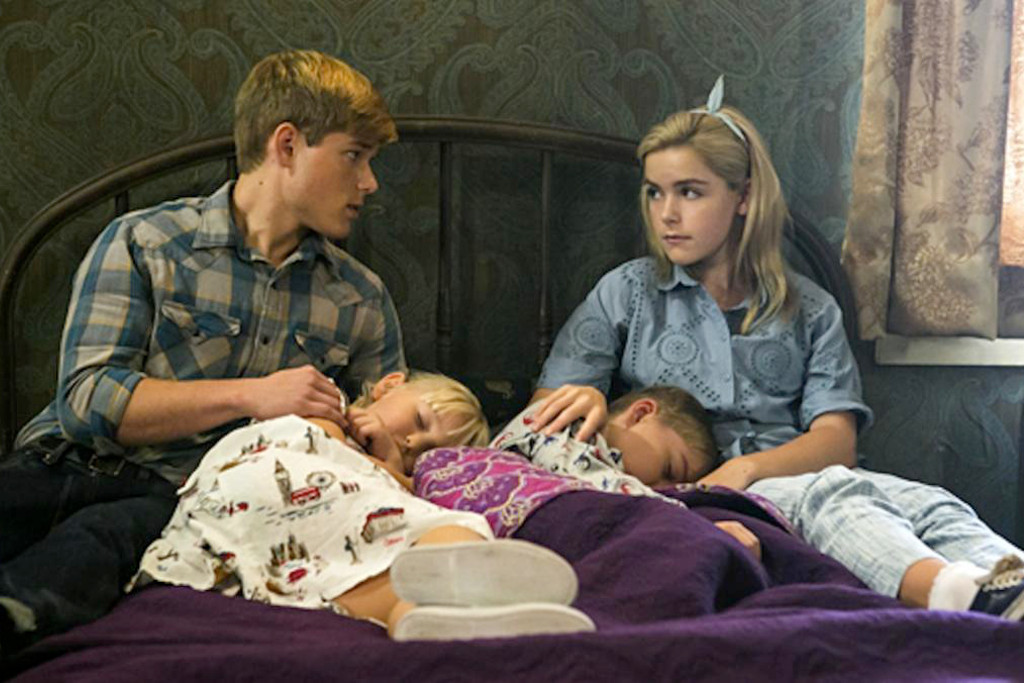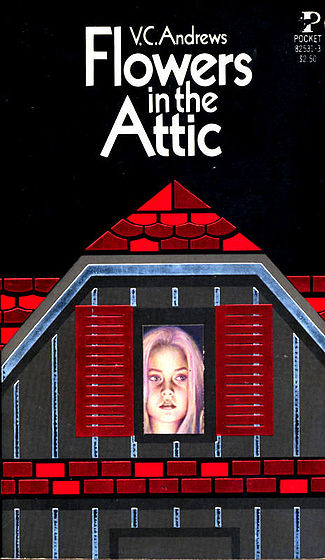Who Else Is Ridiculously Excited About The Upcoming Flowers In The Attic Remake?
Let's revisit V.C. Andrews' insane novel, which is soon to be a Lifetime TV movie, starring Sally Draper.

Oh shit, Lifetime is REMAKING FLOWERS IN THE ATTIC! If this sentence doesn’t mean anything to you, then I guess you have two options: don’t read on, and don’t find out anything about AN INCEST MOVIE STARRING SALLY DRAPER or read on, and celebrate with me in the best way — with your fingernails between your teeth and, let’s face it, your legs kind of clenched tightly together.
–
What is it and why should I care?
For those of you who don’t know, Flowers In The Attic is a cult novel by V.C. Andrews about the Dollanganger family. The Dollangangers are the perfect American family: blonde, tall and glamorous Corrine and Christopher and their four blonde kids (two boys and two girls) are the picture of health and familial love. But tragedy strikes when the brilliant Christopher is killed in a car accident, leaving his pretty housewife with four mouths to feed and no skills except social graces and home decorating.
Imagine, if you will, a mother pulling her hair out with despair and gradually coming to terms with the fact that to save her children, she will have to swallow her pride and turn to her family, who are essentially gazillionaires with a psychotically violent religious streak. Having disinherited her for a mysterious ‘fall from grace’, the wealthy, harsh Foxworths have been kept secret from Corrine’s children. The children are astonished to hear that they have maternal grandparents, and they’re even more perplexed to be told of their part in a complex plan involving Corrine’s father, who is close to death. Corrine harbours hopes of charming him and once again becoming his heir, but to do this, she has to pretend that she has never had children.
When the Dollangangers arrive at grand Foxworth Hall to begin their subterfuge, they are greeted by a stern, imposing grandmother with cold eyes. Immediately, they are banished to a large but rotting and cluttered attic, where they will remain a secret from Grandfather Foxworth. The youngest children, twins, can’t understand why they must be kept captive, but Chris and Cathy, the eldest, notice how their mother’s eyes sparkle as she resumes her former life: dressed in furs and pearls, she gushes of her adventures. Slowly, her visits become less frequent and her promises more vague. It’s clear her focus has shifted elsewhere.
–
Did you say ‘incest’?
Just as Judy Blume’s Forever is a byword for ‘teenage sex’, for many people Flowers In The Attic has become shorthand for ‘shocking incestuous relationships’. The main reason the book (over and above the 1987 film, which completely excised this part of the plot) was passed on, samizdat-style, amongst so many adolescents in the ’80s and ’90s was the incestuous overtones and, eventually, acts between Chris and Cathy, who come of age while imprisoned in the mansion’s dusty attic. Revisiting the book recently, I realised I hardly remembered any of it except for the sexy bits.
The novel itself is a weird beast, and continues with four further instalments (the Wikipedia summaries are something else; spoilers, obviously). Given its embarrassingly clunky prose, it has rightly been categorised as trash horror. The prissy tone of its narrator belies the seriously warped context of the book’s events. Though this veneer of innocence is understandable in the context of the characters’ arrested development, there’s a cloying naiveté to the recollections. For instance, in the prologue, the adult Cathy narrates:
I think of us more as flowers in the attic. Paper flowers. Born so brightly colored, and fading duller through all those long, grim, dreary, nightmarish days when we were held prisoners of hope, and kept captives by greed. But, we were never to color even one of our paper blossoms yellow.
But there’s also something superbly moody and dark about Andrews’ novel. Aficionados of misery memoirs like Jeannette Walls’ The Glass Castle will know that ghastly parents are, all too sadly, not only the products of wildly creative fiction. Despite the pedestrian writing, Flowers In The Attic’s portrayal of four children wilting in the ‘care’ of a mother and grandmother with a deeply damaged relationship is sometimes heartbreaking.
–
Flowers revisited
Ultimately, it’s this tragic core that I’m hoping to see reflected in Lifetime’s upcoming adaptation (set to premiere on January 18). My hopes are high: the trailer, set to an eerie, gorgeous cover of ‘Sweet Child O’ Mine’, promises a beautifully shot film, and the cast is top-notch with Ellen Burstyn playing the steely, staunch grandmother, Heather Graham as Corrine, and Sally Draper Kiernan Shipka playing Cathy, whose life so miserably unfolds in the space of one room.
As demonstrated by Lifetime’s track record, the channel LOVES a trashy heightened family drama. It also loves sex and scandal, so in a way, it’s a surprise they haven’t already attempted a remake of Andrews’ material. The Huffington Post reports that the older siblings in the remake are twins, which is a change from Andrews’ book, and film adaptations rarely replicate a book to the letter. But from the (admittedly brief) sampler, the performances provide a perfect balance between melodrama and anguish. In fact, I’m holding out hope that the remake will be somewhat of a Flowers In The Attic Platonic ideal: subtler and more beautiful than the book it’s based on, while acknowledging the hideously sad but racy frisson of the children’s predicament.
–
Estelle Tang is a literary critic, essayist and editor living in New York. She is a co-mouth at Flavour Palace and a bibliotherapist at The School of Life. Other serious things are here. Non-serious things are @waouwwaouw.
